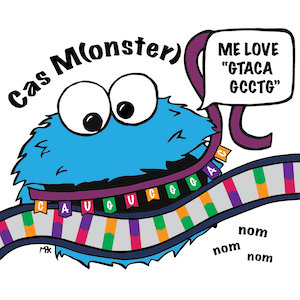“Off-target effects” a vague catch-all term for unintended consequences in an experiment. For CRISPR work, this often means DNA cleavage at unanticipated sites. While off-target effects are nearly impossible to eliminate, it’s essential to understand them in order to design the most specific assays possible. In this blog, we will discuss when off-targets can be an issue in CRISPR, how to predict and minimize them, and ways to control for and quantify them when they can’t be avoided.
What are off-target effects?
The CRISPR-Cas system is an RNA-guided nuclease that either introduces a ssDNA nick, a dsDNA break, or is engineered not to cleave DNA and instead activates/represses gene expression by various mechanisms. The RNA guide is typically 20 nts and the genomic locus must often be proximal to a PAM site for DNA cutting to occur. The RNA sequence and PAM site confer specificity of the nuclease; however, many Cas and Cas-like nucleases are promiscuous. In other words, they can sometimes localize to unintended sites with sequence similarity to the on-target site. When a CRISPR-Cas system localizes to unintended sites and performs its programmed function there, this is an off-target effect.
engineered not to cleave DNA and instead activates/represses gene expression by various mechanisms. The RNA guide is typically 20 nts and the genomic locus must often be proximal to a PAM site for DNA cutting to occur. The RNA sequence and PAM site confer specificity of the nuclease; however, many Cas and Cas-like nucleases are promiscuous. In other words, they can sometimes localize to unintended sites with sequence similarity to the on-target site. When a CRISPR-Cas system localizes to unintended sites and performs its programmed function there, this is an off-target effect.
Should I be concerned about off-target effects?
Depending on your experimental goals this could be a huge concern, or nothing to worry about all. Let’s consider several scenarios below for a CRISPR experiment which involves making specific knock-out edits in a gene(s) of interest and has an average off-target frequency of 5%.
- Your experiment involves making a large sgRNA library to thousands of genes and targeting and sequencing millions of cells. For every individual sgRNA, you recover a minimum of 1,000 targeted cells to sequence. In this instance, a 5% off-target frequency is something to keep in mind, but likely will not have a significant impact on your data.
- You are trying to generate a knockout cell line, with the goal of isolating single cell clones to use for multiple downstream experiments. You only successfully generate 1 null clone and proceed with it. In this case, the likelihood of having an off-target effect in that single clone is low, but since all downstream experiments will rely on that clone not having any confounding mutations, the risk is high.
- You are generating a gene therapy product with CRISPR to (hopefully) be used in human clinical trials. An off-target rate of 5% is far too high when considering human patients and the diseases associated with an elevated mutation burden. The CRISPR platform must be optimized to reduce off-targets and patient risk.
Hopefully you can understand that depending on your platform, off-target effects should impact your experimental design differently. Yes, it is always better to reduce off-target effects, but it’s important to not let ‘perfection’ get in the way of ‘good enough’.
Predicting off-target events
As mentioned in the above section, there are gRNA softwares available which score candidate gRNAs for on-target and off-target event efficiencies. In addition to these tools generating a prediction for off-target levels, most of them will also give you a specific list of the candidate off-target sites. For example, if there are 10 putative off-target locations you can 1) determine if editing at those sites would confound your experimental results and 2) perform targeted off-target measurements at those sites to get an idea of how high the off-target frequency is (more on this below).
Lowering off-target events
There are several strategies to lower the predicted frequency of off-target events, many of which can be combined to lower them even further. While not all of these approaches will work for every experiment, at least one will likely be useful.
Optimal gRNA selection
With some CRISPR experiments, there is hardly any flexibility in gRNA placement (e.g., mutating a specific amino acid or introducing a specified edit). However, if your design does have wiggle room, you can minimize off targets by selecting a gRNA with low sequence similarity elsewhere in the genome. There are many predictive online tools which can not only find gRNAs for you, but also score their probability of off-target events: CRISPOR, Cas-OFFinder, CCTop, and many more.
While such software typically only considers DNA sequence and doesn’t take into account chromatin context and other factors, they are easy to use and can reduce off-targets at a fundamental level.
Optimal Cas selection
Once you’ve selected a gRNA with low sequence similarity elsewhere in the genome to reduce off-targets, it is time to consider your Cas enzyme. Even if there are similar sequences present in the genome, certain Cas enzymes are less compatible with the bulkiness that accompanies mispairing of bases. To reduce off-targets, you’ll want to select a Cas enzyme with low tolerance for mismatches within the gRNA sequence.
 |
| Graphic courtesy of Maya Kostman. |
The most commonly used Cas, spCas9, has gone through multiple rounds of optimization which have led to more specific variants. HypaCas9, sSpCas9(1.1), SpCas9HF1, and evoCas9 are a few spCas9s which have been evolved or mutated to be more specific for exact gRNA matches (Rabinowitz and Offen). Of note, most of these optimized Cas enzymes prevent cutting at mismatched guide sites, but not necessarily binding to these sites. Thus, these enzyme swaps will only reduce off targets where nicking/cleaving of DNA occurs, not for deadCas activator/repressor experiments where only localization of the Cas occurs.
2 gRNA approach
Off-targets that come from mutations arise from base/prime editing or Cas cleavage. In the case of Cas cleavage, off-target mutations can be mitigated by using two gRNAs in close proximity that guide Cas nickases. When two nicks are generated near each other, this will result in a DNA double strand break (DSB), the event required for frameshift and knock-in mutations. If one nickase acts on an off-target site, it will generate a ssDNA break which can easily be repaired by cells with a near zero likelihood of mutation arising. The probability of the two gRNAs having off-target sites within a close enough distance to each other to cause a DSBs will be very low, reducing off-target cleavage.
How to quantify off-target events
Even after you’ve reduced the chance of off-target effects, you still need to do your due diligence to ensure they are indeed a non-issue. Above we mentioned how to predict off-target frequency and even identify where those off-target events may occur. However, these tools can only generate predictions of these outcomes. Rigorous analysis is essential to ensure off-target events are below a given threshold for certain experiments where they can’t be tolerated. Below we will outline several options to quantify these events.
Whole genome sequencing
The only way to quantify off-target effects entirely is to perform whole genome sequencing. While this may be unnecessary for many applications, it is the only comprehensive method available.
Targeted sequencing approaches
More targeted alternative sequencing approaches have been developed. Cas ChIP-Seq, where only DNA sites bound by Cas are sequenced, has been tested with some success. The major con is that binding by Cas does not always correlate with catalytic activity at those sites, especially when DNA mismatches are involved.
Two other approaches have been used - GUIDE-Seq and integrase-defective lentiviral vectors - which rely on insertion of DNA by the NHEJ pathway during DNA repair of the break to allow for site-specific detection downstream. The con to these approaches is that NHEJ must perform the repair to allow for detection, not Homologous Recombination or Alternative End Joining, two alternative pathways. See (Guo et al, 2023) for a review of other targeted sequencing methods.
Candidate site sequencing
Sites with high sequence similarity to the gRNA can be sequenced. These sites can be selectively sequenced to determine if there are significant editing events, serving as a proxy for total off-target effects.
Quantifying off-targets for non-cutters
If your Cas experiment involves activation/repression or any other effect which does not depend on a DNA mutation, off-targets must be quantified slightly differently. For a comprehensive approach, RNA-seq would be an appropriate method for an activator or repressor Cas. Similarly, Cas ChIP-Seq would also identify all DNA binding sites within your experiment. For a candidate site-specific approach, mRNA quantification or western blot of putative off-targets would be suitable.
How to control for off-target events
Sometimes there just isn’t a way around off-targets. Your experiment may not have flexibility with gRNA selection, or maybe you just can’t get them below a given threshold even when you’ve tried everything listed here. For some applications, this is ok, but it still must be controlled for and acknowledged as a potential limitation in a study.
Strength in numbers
If you assess your off-target frequency to sit at a level of, say 5%, then the majority of single cell editing events will be on target. Thus, if you isolate/sequence/whatever your editing event outcome is at a reasonable number, the likelihood of an off-target confounding your results should be minimal. For example, if your goal is to generate a knock-out cell line to perform downstream characterization of, isolating 2 or 3 distinct clones to perform key experiments on is a good way to control for off targets as well as clonal differences. If you are performing CRISPR library screens, the same principle holds true - the higher the number of distinct editing events, the lower the likelihood of an off-target artifact. Increasing the N in your experiment is the only way to effectively control for off-targets and significantly decrease the probability of artifacts.
Off-target controls
A seldom used control for targeted CRISPR experiments is a ‘non-targeting’ gRNA, a gRNA which doesn’t perfectly match any site in the genome. While this may effectively serve as a transfection or transduction control, a different gRNA would have distinct off-target sites, eliminating its effectiveness as a control. Since off-targets typically confound an experiment due to their location (e.g. in a gene in a similar pathway, a growth factor, etc.) this control is usually not very meaningful. Unfortunately, there really aren’t any effective off-target reference controls.
Off-targets and your experiment
Every experiment is unique and off-target risks will vary depending on many factors. Hopefully now you have all the resources you need to determine what your risk level is, how to lower it, and how to ensure off-targets don’t mess with your results when they do arise. Happy CRISPR’ing!
References and Resources
References
Rabinowitz R, Offen D. Single-Base Resolution: Increasing the Specificity of the CRISPR-Cas System in Gene Editing. Mol Ther. 2021 Mar 3;29(3):937-948. doi: 10.1016/j.ymthe.2020.11.009
Guo C, Ma X, Gao F, Guo Y. Off-target effects in CRISPR/Cas9 gene editing. Front Bioeng Biotechnol. 2023 Mar 9;11:1143157. doi: 10.3389/fbioe.2023.1143157
Resources on Addgene.org
- CRISPR software and resources
- Addgene CRISPR Guide
- Addgene’s CRISPR 101 eBook
More resources on the Addgene blog
- CRISPR 101: Which Cas9 do I choose for my CRISPR experiment?
- CRISPR 101: Cas9 The Other Cas(s)
- CRISPR 101: Validating Your Genome Edit
Topics: CRISPR 101





Leave a Comment